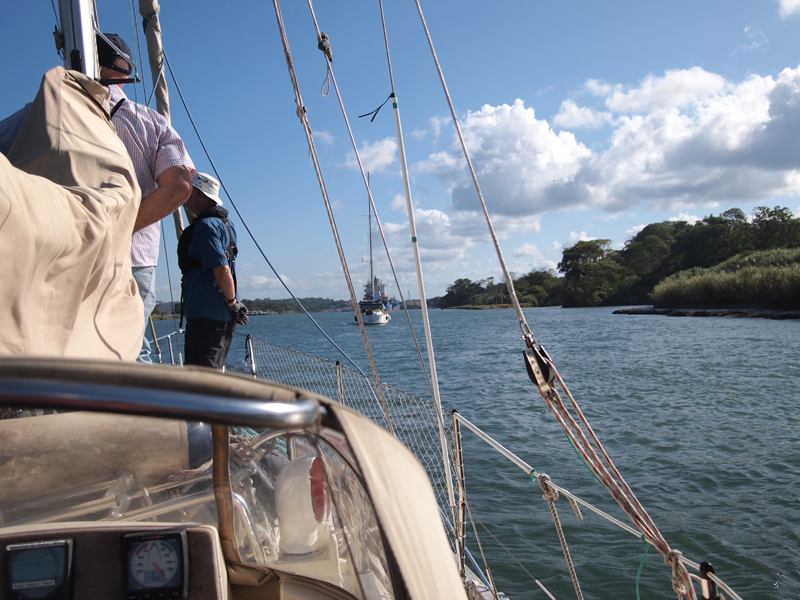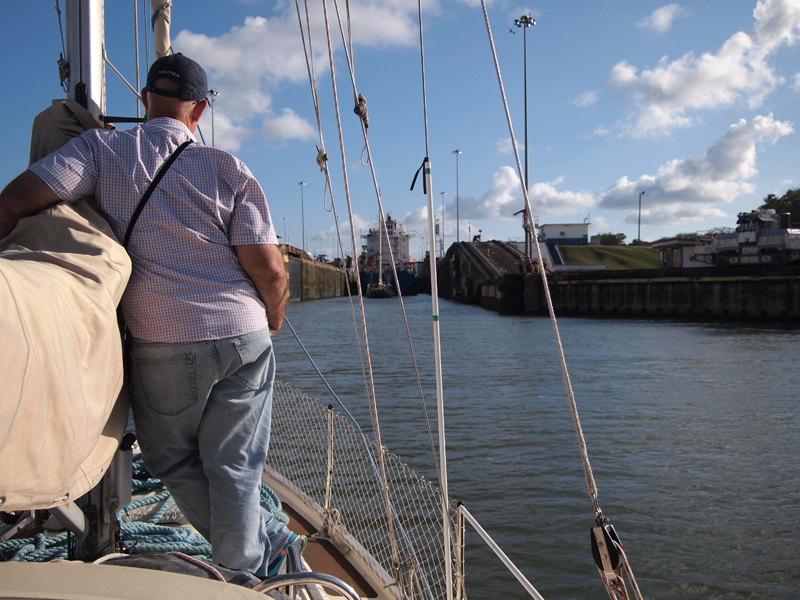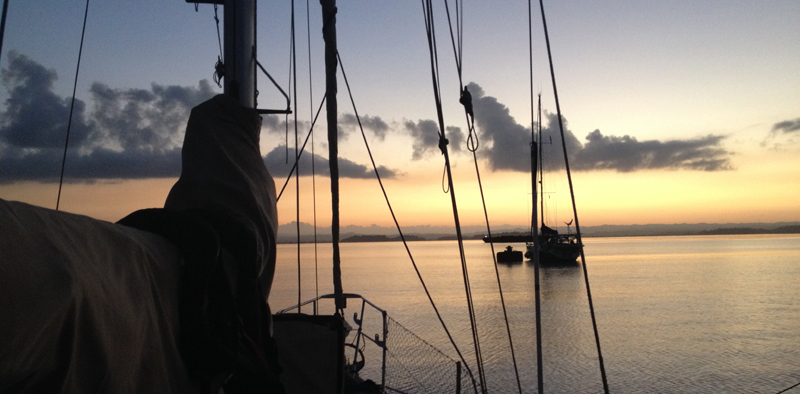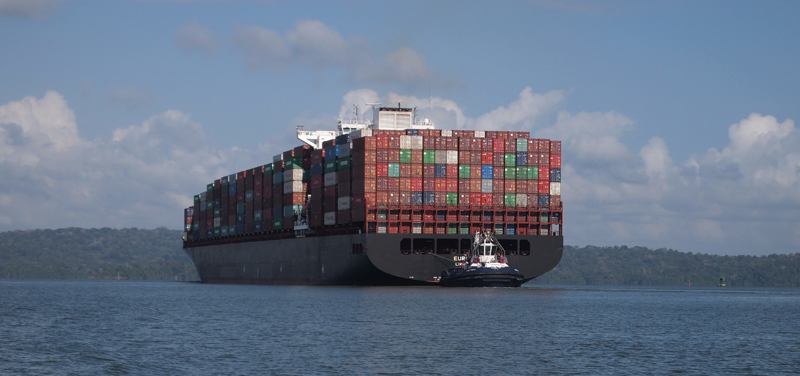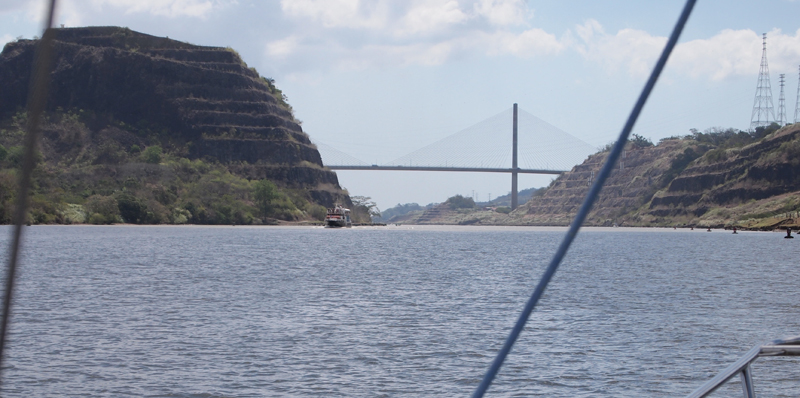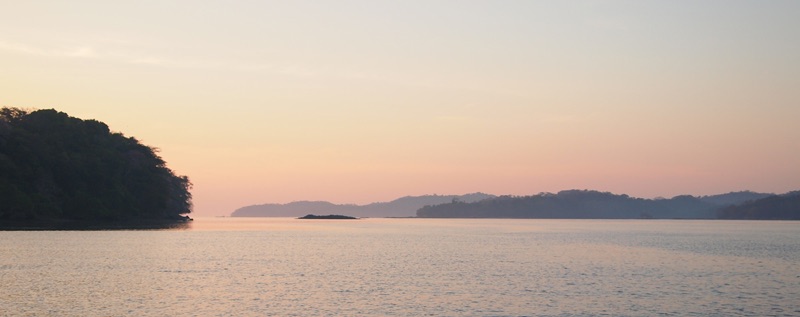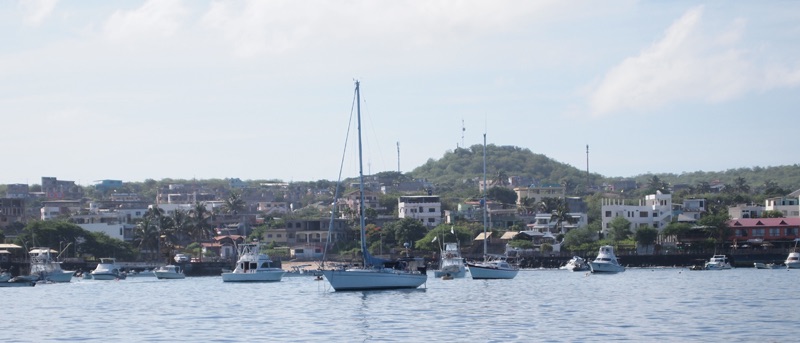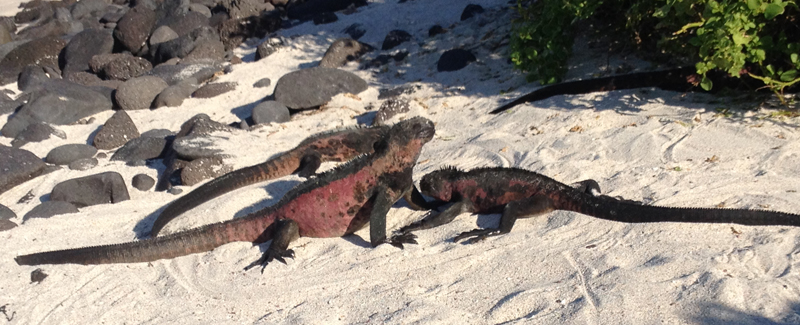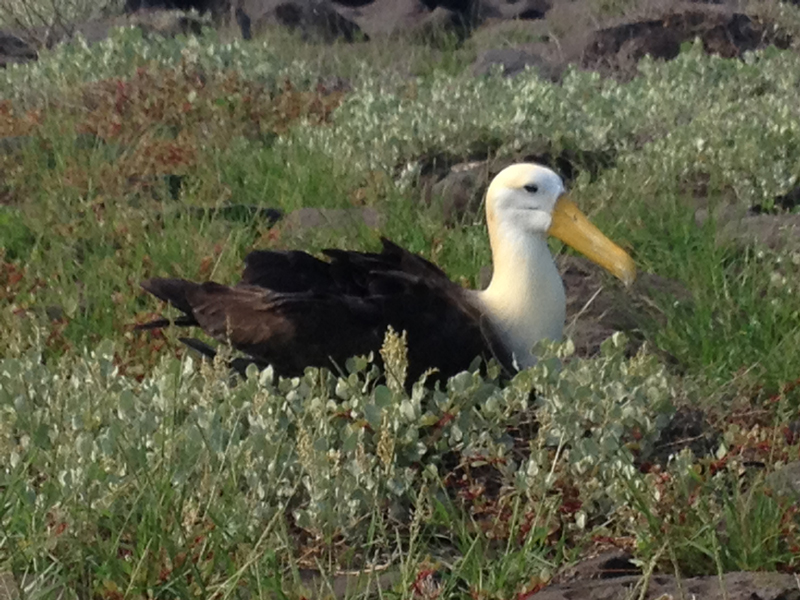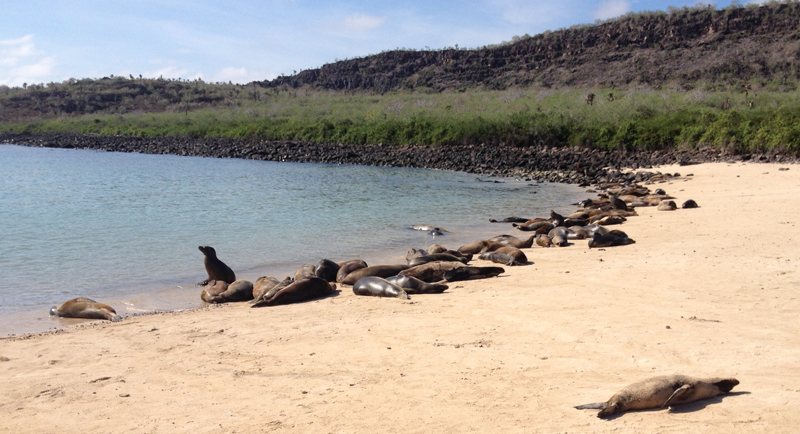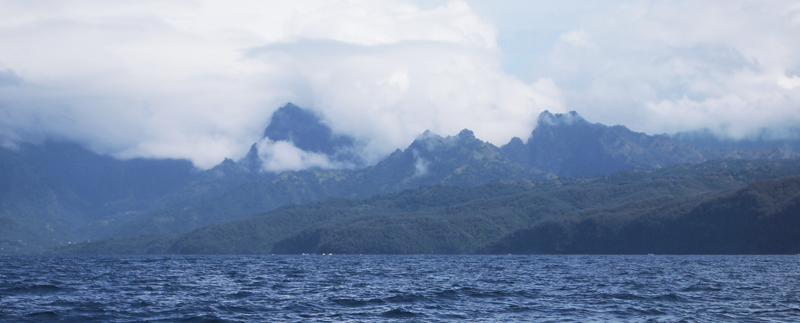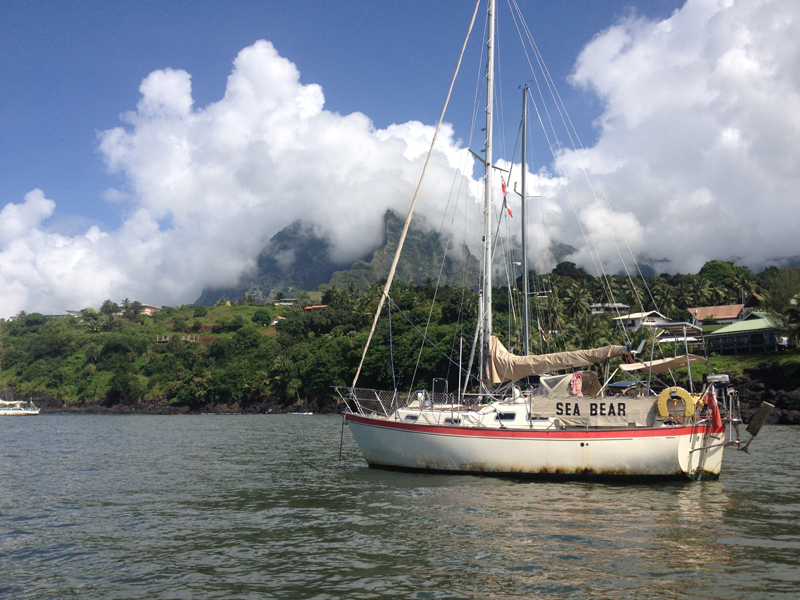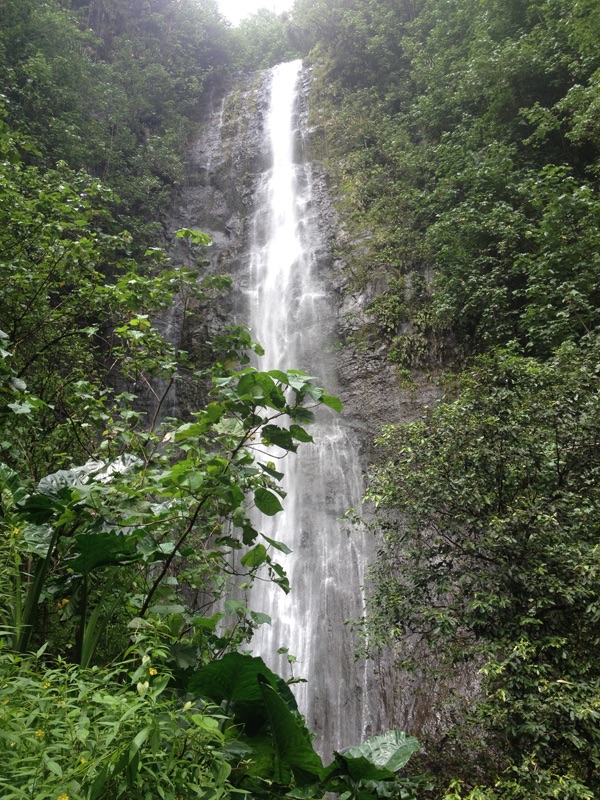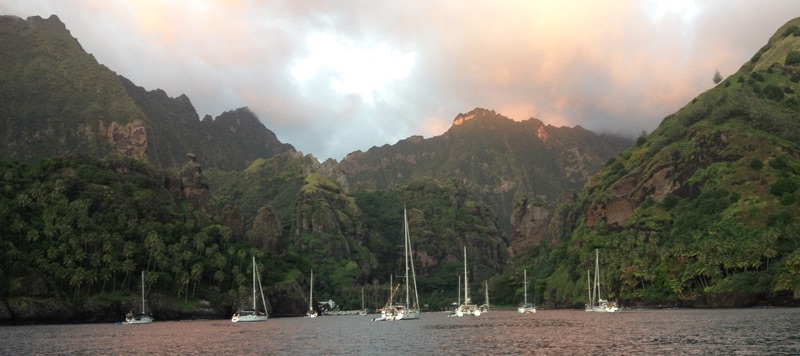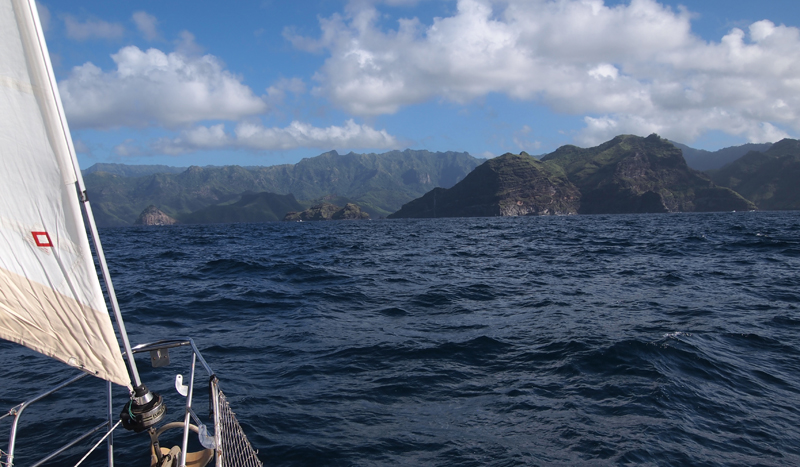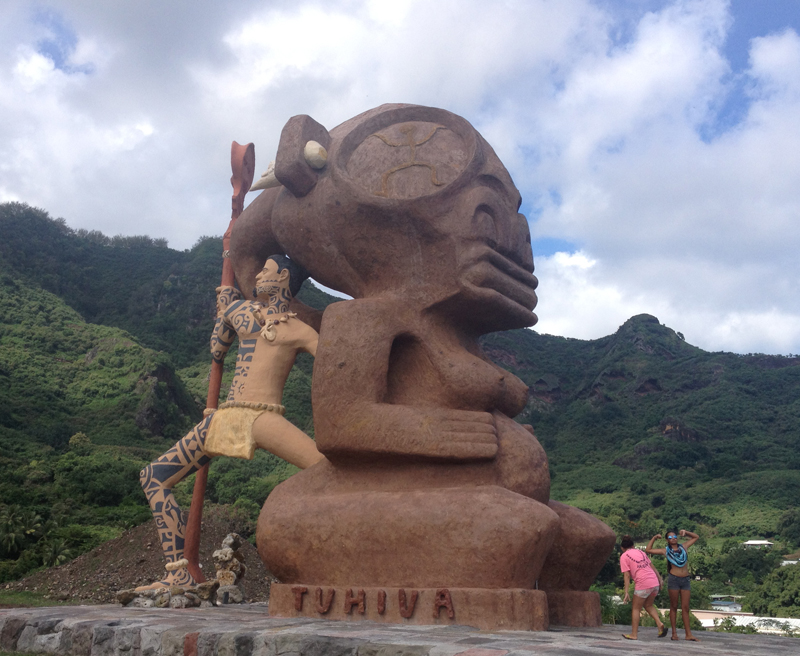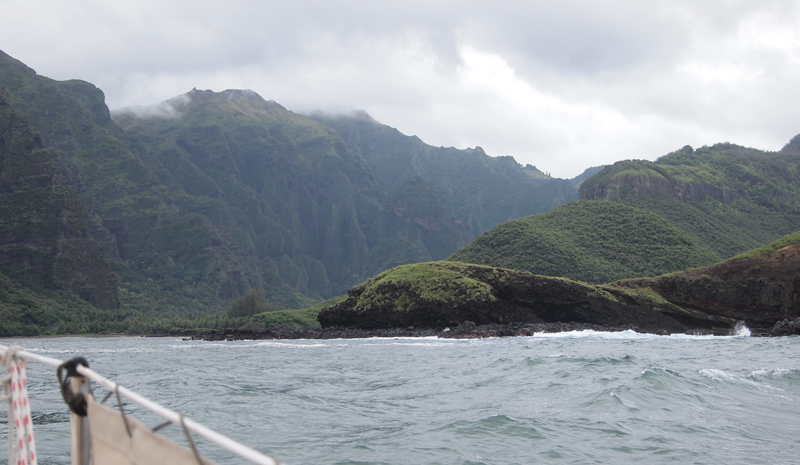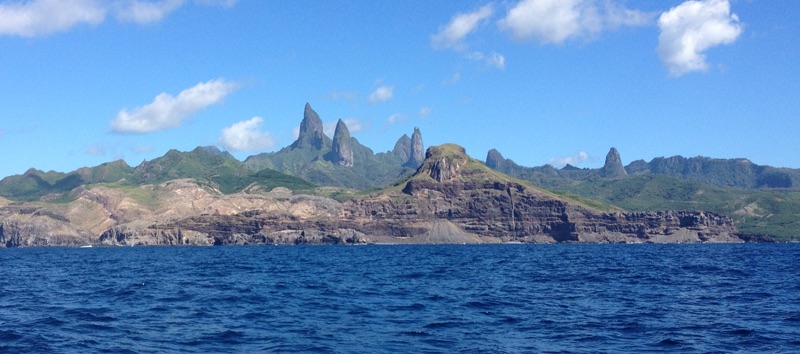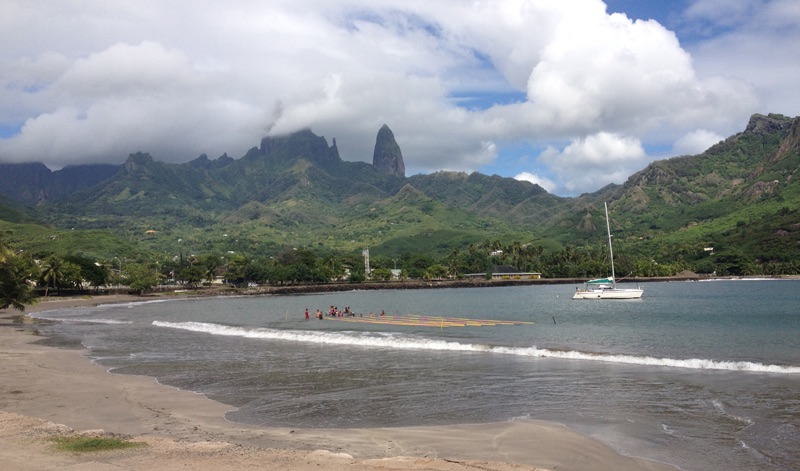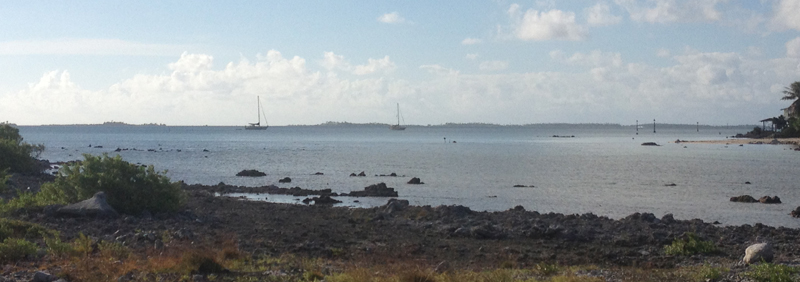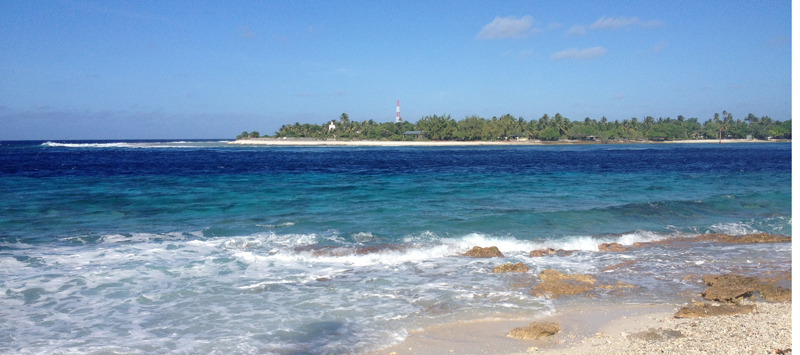13th – 18th February Panama Canal
A few days before my own scheduled transit I went through the canal as a line handler on Philip’s boat Wandering Star, a 45’ Irwin ketch. The other line handlers were an English couple from Morpheus, my neighbours on the pontoon and a young Panamanian Carlos. Late afternoon and we picked up the transit advisor at the Flats anchorage and motored to the Gatun locks. Before entering we rafted up with a catamaran in the centre us to starboard and a big pilot house ketch to port. The Panamain canal line handlers ashore threw us hauling lines weighted with monkeys fists, we attached the mooring warps to them, we were walked into the lock and once in place the linehandlers ashore dropped the loops over bollards and the linehandlers on the boats took up the slack. Lock doors closed and water flooded in, the turbulence was considerable, there was a lot of strain on the lines and taking in the lines as the raft rose was hard. There are 3 Gatun locks and we passed from one to the other with the linehandlers ashore casting us off and walking us through to the next lock. Going through at the same time was a big freighter in front of us, they have only a few feet clearance either side so move very slowly, guided by the mules( electric trains) to which they are tied so it all took some time. By the time we were through the 3rd lock and could de-raft it had already been dark for some time and we motored to anchor near the designated mooring bouy to spend the night in Gatun Lake. Our transit advisor left us and we could settle down to eat and drink a few beers.
Resuming the transit the next morning with a new advisor, we motored across the lake then through the cuts past Gamboa and through the Gaillard cut, past Gold hill, under the Centenario bridge and so to the San Pedro lock where the descent to the Pacific begins. Rafting up again we entered the lock , this time in front of a freighter. Down-locking is much more gentle with no turbulence. On through the Minaflores lake to the 2 Minaflores locks and then finally to the Pacific. Just a few more miles and under the Bridge of the Americas and there is Balboa Yacht Club with its moorings. The club boatman ran us ashore and we said our farewells to Philip and taxied back to Shelter Bay. It was a worthwhile experience and had prepared me for my own transit.
For my transit I enlisted the English crew of Tintin, recently arrived and scheduled to transit a few days later. Motoring out of the marina Sea Bear felt heavy and sluggish with 5 aboard. At the flats waiting for the advisor I talked through the procedure with the crew and when the advisor arrived we set off for the locks.
Sea Bear was rafted alongside 2 big yachts and the advisors said the 2 big yachts would do all the line handling and manoeuvring. We were just grateful passengers and so had an easy time of it. Passing through the Gatun locks was quicker this time so we were moored up to the big buoy before dark. Dinner was cooked and eaten and some beers drunk. Now Sea Bear has only 3 bunks so I slept in the cockpit and another elected to sleep on the foredeck It was a fine night.
The advisor had warned that they would be early next morning and indeed Larry, our new advisor turned up at 6.45 and we were off. Tea was already brewed so I let one of the crew helm whilst I cooked breakfast for all.
When doing your transit application you must specify your cruising speed, I had specified 5 knots, this is the minimum speed allowed. I was little concerned at being able to maintain this especially so heavily laden as we were but we averaged 5.7 for the next 5 hours that we took to motor the 28.6 mies across the lake and to the San Pedro lock, where we arrived at 11.45. The lake is quite beautiful with lots of tree covered islands, on the biggest of which is the Smithsonian Tropical research station. We did this time see a crocodile basking in the shallow of one island.
Down-locking this time was quite quick, no big freighter to wait for, rafted together again with Arielle, and a French Onvi, we locked through with a big sail training ship and a passenger ferry.
Exiting the San Pedro lock we spotted another crocodile. Shortly after 2pm our advisor was picked up and we moored to a mooring buoy at Balboa Yacht club. It had been and easy and stress free transit.
I went ashore in the club boat with my crew and dropped of the tyre fenders (3$ each to hire 1$ each to drop off). The crew of Arielle were at the yacht club and we drank some beer before they went off in the taxi that we had pre-arranged back to Shelter Bay.
Connected up to wifi I discovered that John Whittle, an old friend and work associate from my time as a climbing guide had suddenly died. So no joy at being through to the Pacific. The day ended on a sombre note and I drank the last of my beer in remembrance of him.
19th – 23rd Feb – Panama City
I spent a few days at the Balboa Yacht Club moorings, I had been led to believe that they were very rolly with wakes from big ships but I found this not to be the case at all.
Making final preparations for the Pacific I spent some time visiting several chandlers but I couldn’t get all the bits I wanted which I found a bit surprising in such a big place. I did in the course of my wandering use the Metro subway, very fast and efficient in addition to taxis and the metro bus.
I did get a chart for Tonga which I was missing and a new Nautical almanac from Islamoradora the excellent chart agents in Balboa.
I went to the open air vegetable market at Abastos which was huge and bought lots of good quality unrefridgerated fruit and vegetables which keep much better than cold stored supermarket ones for the journey. Another purchase was a new windup kitchen timer – just the thing to time your catnaps at sea, though I wont be able to doze with it on my chest as used to be my wont with my old one as it it egg shaped and so would roll off.
International zarpe got from the Port captain at Flamenco and Immigration visited,
I went to get diesel topped up and whilst moored up some clot in a work boat who was moored astern decided for unknown reason to reverse into me. There was a horrible noise and the wind vane paddle was horribly bent. I was fuming as you might imagine. The design of the monitor is such that there is a sacrifical tube between paddle and gear mechanism and it was this that was bent. I do carry a spare but I wasn’t about to tell the other boat that. A yacht club offIcial on the fuel dock was helpful taking all the details . I took off the paddle and stripped out the tube giving it to the guy on the dock who said he would insist it was fixed today as he knew I was leaving. I went back to the mooring to wait. They came by later but it was still not quite straight so he went away again. They came back later with a new one which was a better result and I have also got the old one which is not quite straight but will do as another spare at a pinch. Have just finished putting it back on which involved some slightly dodgy sitting on the back framework.
All ready now think I need a beer after all it will be last one for a while.
First stop is planned for Las Perlas islands about 40 miles away then it will out into the Pacific proper for the long haul.
24th Feb – 9th March – Las Perlas & passage to Galapagos
Left Balboa moorings at first light and after motoring out of the channel set a course for the Las Perlas, a cluster of over 20 mainly uninhabited islands about 40 miles away. Little wind so mainly motoring until later on when I picked up a southerly breeze. I eventually anchored off the NW coast of La Contadora, the busiest of the islands, a weekend retreat for rich Panamanians. Next day I moved on to a lovely anchorage in the channel between Isla Espiritu Santo and the main island of Isla Del Rey. Supposedly a popular anchorage but I had it all myself, it was very peaceful, lots of pelicans and parrots.
Now I could start the task of diving under and ensuring the hull was clean before passage and that afternoon I got 1 side done but I find it tiring work. Wanting to finish the job off next morning but the tide was running swiftly past the boat and I decided it wouldn’t be wise. Yes welcome back to tides, something you almost forget about in the Caribbean, here the range is about 15 ft. I therefore moved on, motoring down the east side of the islands to almost the southern end. Here I anchored at Rio Cacique which the pilot assured me you were almost certain to find flat water. So it was I and I finished off the hull cleaning.
A quick dive next morning as a final check then it was time to leave, this morning at least there was some wind and from the North so I set off for the long passage bound for the Galapagos. Probably like many other cruisers I had some regrets at not having more time to spend exploring in these delightful islands but the Pacific beckoned.
I did have a calm patch passing between wide gap between Isla Galera and Punta Gorda but then the wind was back. A notable sight was the sting rays jumping vertically from the water, turning end over end and landing with an almighty splash.
So the day passed and the first night, lots of big ships bound to and from Panama but all a good distance off. I was off to a flying start because in the first 24 hours Sea Bear had run 130 miles. However it was not too last and the winds grew lighter and lighter with some periods of calm. I don’t think I saw winds over 8 knots again. So the days passed, once clear of the shipping channel there were no ships and little to do apart from ring the changes with the sails, pole out the yankee opposite to the main, lets try the cruising chute, the occasional gybe to keep on course as far as possible, a little tweak to the self steering now and again. On the 8th day I was a little surprised to see a fishing vessel must be 200 miles at least from the nearest land.
After sunset of the 9th day and a big bird made a determined effort to land atop the mast, succeeding after several attempts. I guessed it must be a land bird as a sea bird would just settle on the water, but I wasn’t able to identify it, it perched there all night leaving with first light in the morning.
My patience with these calms and light winds was wearing thin so nightfall of day 10 when it fell calm and there was about 50 miles to Isla Cristobal I resorted at last to the engine. It didn’t help that the auto pilot had packed up so hand steering it was. The wind did return for a while but not for long and when it died again I let let drift and took a 30 minute nap before turning on the engine again. It had been a lovely full bright moon night but eventually it sunk below a thick band of clouds so it was really dark, now I know there is an island somewhere hereabouts. First light and all was revealed and I was shortly entering Wreck Bay there to anchor. It had been 10 days short 1 hour for the 838 mile passage.
10th- 27th March Wreck Bay, San Cristobal & more Galapagos
I was a little surprised how green was the island after all I had read. Plenty of trees and vegetation, but then I suppose it was the rainy season.
First thing after anchoring was a dive over the side to check the bottom of Sea Bear, it had accumulated a crop of goose barnacles so those were scrapped off. A big boxy fish (puffer fish) came along to help, tugging them off and eating them.
Formalities took some time to complete, it all has to be done through an agent . At one time there were 6 official aboard plus a diver inspecting the hull. It was all very friendly though and no problems although expensive, I just had to be fumigated in the morning. For that I had to be off the ship for 3 hours so I explored the town, watched the sea lions, swam at the beach and found a nice restaraunt for a 4$ fish meal.
Subsequent days saw me walk to the beach and Lobelia for my first sight of marine iguanas, more sea lions of course, this place is ruled by sea lions. Birds including the famed finches, a lava heron, white checked pintails, oystercatcher, a plover and of course plenty of pelicans and frigate birds.
Another day I took the bus (they only run on a Sunday) across the island passing through the farming area of El Progresso to La Galapaguera, a breeding project for giant tortoises a walk around here and then on to Puerto Chino, the end of the road and a walk to another lovely beach. No sign of a bus back so after a long wait I rode back in the back of a pickup truck which is what all the taxis here are.
Boat maintainance carries on, this time it is major re-stitch of the seams of the spray hood where the stitching has either frayed through or rotted by sunlight and sea air. Its hard awkward work.
There is only the one road so some days later I rode my bike up past the highest point, Cerro San Joaquin (896m) to El Junco where I walked up to see the crater lake. That was some hard ride but much easier freewheeling back downhill. I got soaked in a downpour but you don’t get cold here near the equator so it barely matters.
Leaving Sea Bear at anchor I took a launcha (fast motorboat with 3 big outboard engines that do the 40 nm trip in about 2 hours) over to Puerto Ayora, Santa Cruz to meet up with my son Ged who flown into the Galapagos. We visited the Darwin centre and walked to Turtle bay then managed to arrange a few days on a tourist boat. This was very good indeed, food superb and the wildlife guide very knowledgable and informative. We visited giant tortoises in the highlands of Santa Cruz then the boat took us overnight to island of Espanola where we walked ashore on Gardner bay for sea lions and marine iguanas, snorkeled in the bay seeing turtles. On then to Punta Suarez for a walk across the peninsular though marine iguana breeding sites and masked booby colonies.
Even though it was a little early in the season we were lucky to see one waved Albatross.
One of the features of the Galapagos is the fearless nature of all the wildlife meaning that you can approach really close which is very special. Here we also saw the Galapagos hawk.
Next was island of Santa Fe for the cactus trees and land iguanas found only on this island. Then to South Plaza, a different type of landscape, a different type of iguanas plus nesting on the cliffs, swallow tail gulls, blue footed boobies and Audubon’s shearwaters. Throughout there were frigate birds , tropic birds, finches, mockingbirds and Galapagos doves.
Tour finished we bussed over Santa Cruz to Puerto Ayora and Ged and I returned by launcha to San Cristobal to rejoin Sea Bear.
We had a fabulous snorkel in a rocky cove underneath Cerro Tijeretas with big schools of fish, many brightly coloured big fish and with sea lions swimming really close to you.
But my time in the Galapagos is up, it has been fabulous, but now its time to arrange my zarpe, clear immigration, stock up with water, veg, fruit and bread and head on out for the Marquesas. They are about 3,000 mile away so 30 days or more.
30th March – 3rd May – Passage to Marquesas & landfall at Hiva Oa
I had a what I think to be a very slow passage following just about the great circle route which differs not a lot in these latitudes from the rhumb route. I’ll not bore you with the full details but I can understand why Connor O’Brien, who was the first Irish yacht circumnavigator, said if he had to sail 5,000 miles in the trade winds that he would die of boredom. Still as the great Moitessier said, cruising is one long game of patience.
I’ll just add trade winds what trade winds! The pilot books had assured me I would be gently wafted from Galapagos to the Marquesas by the SE trades
Leaving the Galapagos I had no wind then a succession of squalls , one which caught me unawares on a grey drizzly morning when the wind went from 10 knots to 35 – 40 in a matter of moments and torrential rain. It was one of those moments which bought to me how alone you are out here and far away from any help. Then the weather improved for some days but I still had a series of grey overcast days with no sight of the sun. The winds were light many days of 8- 9 knots of wind and sometimes lower. At first they were indeed from SE, living up to their name and we could sail along on a broad reach but then they went E even NE so it was dead downwind, a point of sailing that neither Sea Bear nor I agree to like and there was always enough swell to create at times, lively rolling which was tiresome.
It amazed me how quickly weed and barnacles grow on the bottom in these waters. I had started out clean but after a week already had a fair growth and it doesn’t take too much to slow the boat down and make her sluggish and unresponsive on the helm. One day when the wind was only 3 knots i did launch the dinghy and try and scrape some away but there was too much swell and I adjudged it too dangerous.
There is very little boat traffic this way and I only saw 3 boats, one a freighter and two fishing boats, still with a guard alarm set on AIS it does mean you can get some decent sleep.
The last few hundred miles seemed to take forever, I think i know what its like to be in limbo now.
The penultimate day around midday I spied land, at first not quite sure, was it cloud but no a bit later I was certain Land Ho. The Marquesas are high mountains and I was still 45 miles off.
There was no chance to get in before dark that night so when about 20 miles of I hove too and drifted slowly towards them. Dawn I let draw again, what magnificent islands steep mountainous and verdant and largely unspoiled.
Later as I turned into Atuona Bay, Hiva Oa, I met with Thom on another Vancouver 28 just leaving.
I anchored in the bay, I had made it to one of the most remote group of inhabited islands in the world, Gauguins paradise.
2995 nmiles and 34 days
4th – 18th May – Marquesas
Hiva Oa
Always the first job once the boat is securely anchored is to register with the Authorities. A walk of about 3 kilometers took me to the town of Atuona. At the Gendamarie I discovered that the time zone here is half hour different not 1 hour which is the usual step in time from one zone to another, and the place was shut until after lunch. At that prompt a visit to an ATM saw me furnished with funds, but I had no idea of the exchange rate, although the Polynesian Franc notes were very colourful and pretty, and I could have lunch myself, a real treat after so long on the boat.
Later formalities were initiated very easily, but I had to post the form the Gendarmes gave me to Papete, Tahiti where I would have to visit to complete things when I got there.
Next a visit to the shops and a real treat in baguettes and french cheese, that would go well with my last bottle of french wine as a celebration of arrival. Ooh and some tins of cold Tahitian beer, one drunk on the spot, perhaps thats why the walk back to the boat seemed so long.
I spent a few days at Atuona, looking around and enjoying land.
A river emptied into the anchorage bay and it rained a lot meaning the water was very muddy but one benefit of this was that all the fresh water killed off the goose barnacles and weed on the hull.
Fatu Hiva
Leaving Hiva Oa it was about full moon I thought to have a pleasant moonlit sail to Fatu Hiva. At about 45 miles away it was just to far to guarantee managing all in daylight. It is one disadvantage of sailing in the tropics 12 hour days and 12 hour nights. As it was it turned out very cloudy.
Arrived in Baie Hanavave or Bay of the Virgins, a truly spectacular anchorage, steep sided and dominated by rock pinnacles and behind a backdrop of steep high mountains.
The island is very unspoilt and the people super friendly. Went to a dinner of traditional fare for cruisers anchored in the bay hosted by a family from the village. Roast pork, roast goat, breadfruit, coconut milk, roasted pink bananas & pamplemousse was amongst the items on offer.
One day a walk took me to a lovely 200 ft waterfall up the valley behind the village where I skinny dipped in the plunge pool, very refreshing. Another walk took me high above the bay looking down on the boats at anchor.
Tahuata
Another night sail took me to Tahuata where I anchored at Baie Hanamoenoa, reckoned by one authority to be one of the 3 most beautiful anchorages in Polynesia. An uninhabited bay with a yellow sand beach back by coconut palms and a backdrop of green hills. Very soft and gentle by Marquesian standards I thought.
From there I thought to visit a bay on the North coast of Hiva Oa, said to be good for ancient Polynesian sites however after all the light winds I had a day of very strong wind with a big breaking swell so it was not to be and halfway there I changed my objective and headed across the 80 miles to Nuku Hiva. A fairly rolly polly night but an early morning arrival in Taiohae bay. I anchored next to Thom’s Vancouver28.
Nuka Hiva
19th – 25th May Taiohae bay
Then bay is very big and able to accommodate lots of yachts at anchor so is a major gathering point in the Marquesas for cruisers. The town ashore is the biggest in the Marquesas so there are shops, a bank, restaurants etc so it is a good place to re-provision and relax. However all the supplies come in by boat which was due in a few days, in between shipments they do run out of things so for the first few day here the shelves were thinly stocked and they had run out of flour so there was no bread to be had.
Thom was anchored here so it was good to catch up and compare notes as it were on our Pacific passages so far. We also looked over each other boats which although the same model had a few differences in layout and set up.
There were also here some other cruisers that I had got to know so it was a fairly sociable time.
Whilst here I took a few local walks and had a second go at repairing my leaky dinghy not entirely successfully.
26th-29th May – Baie Tai’oe
My next move was to another bay about 5 miles along the coast, Baie Tai’oe. The entrance to this was hidden and looked rather improbable at first entering between a rocky point with breaking waves and tall vertiginous cliffs and with quite a swell running a trifle daunting.
Once inside though it was sheltered, calm and peaceful and you couldn’t even see the ocean.
Thom arrived next day with a new crew member for me. I had mentioned the other day when a group of us had a pizza together that I was a bit concerned about passing through the Toumotus or Dangerous Archipelego without a crew to watch for reefs and coral heads in the passes and here almost out of the blue was a volunteer to come with me.
Beside the spectacular scenery of this bay, one of the attractions was the 3rd highest waterfall in the world being up the valley. Next day I dinghied around to the village of Hakaui, population 10, and walked up the trail to Vaipo falls. The trail was wet and muddy and you had to ford a knee deep fast running river. You were rewarded with a wonderful view at one point before pushing on through the forest.
All around were the ruins of ancient paepae or house platforms, at one time the valley must have supported a large population.
I got back to the village before it started raining then had an exciting time going back out through the surf to the boat, thought I might get flipped but just took a wave aboard.
Went back to th e village next morning and filled my water cans and bought a whole load of fruit, a hand of bananas, pamplemousse, limes and a breadfruit
30th May- 1st June Hakahau, Oa Pou
Weighed anchor early from Baie Taiohae and set of for the island of Oa Pou about 25 miles away. We were rewarded with blue skies and moderate winds and a fairly calm sea so had a nice sail across.
It is very dramatic island with tall rock spires, the tallest is Mt Oave, a volcanic plug at 4,004 feet high. There was hardly any cloud when we approached so we could see them in all their splendour but since they have been hidden in the cloud.
Hakahau with a population of about a thousand is the 3rd most populated village in the Marquesas, but feels a sleepy little place. We are anchored in the bay behind the breakwater which gives some protection from the swell.
This will be the jumping off spot for the Toumotos about 450 miles away and we will set off when the weather looks suitable last night was very windy and it has kicked up quite a sea outside so we will wait for that to settle before making passage.
2nd -8th June Oa Pou to Ahe, Toamotos
Mixed weather for the 450 mile passage to the Toamotos with very variable winds in strength and direction from SE to NE and 3 days of very cloudy grey conditions. However it was never too windy nor too rough so no complaints on that score. Another passage with no sightings, no dolphins, no whales and just one fishing boat as we closed on Ahe in the early hours of the last morning. Our trailing of a fishing line proved unsuccessful too. We managed to hook two, both reel screamers, both big but the first just bent the hook and the second broke the line like it was a piece of week cotton.
The Toamotos earned their reputation as the Dangerous Isles because the Motos & coral reefs are so low lying and hard to spot and we did not sight Ahe until we were about 5 miles away, a thin line of coconut trees fringing the horizon.
On Ahe there is just one pass into the lagoon, about 85 fett wide at its narrowest and just 3-4 metres deep over the bar. Through this rushes all the water in and out of the lagoon with the tides so a slack water passage is recommended. Only having the tide times for another atoll Rangiroa about 90 miles away we had to guess and rely on the look of the water. Motoring in we had about 2-3 knots of tide against us, so slow progress but plenty of steerage way. Once inside over the bar current slackened and we could follow the marked channel across the lagoon to anchor off the village of Tenukapara.
Even though Ahe is one of the smaller atolls the lagoon feels vast inside and strange to be encircled by all the islets which comprise the rim. Strange too that night when the boat was so peaceful on the anchor, so still, no rocking or rolling, it was hard to remember when the boat had last been that quiet aboard, the San Blas Islands I think back in January.
The people in the village are super friendly. I was outside the PO and a women asked if I had any music. She rushed off for a memory card and I put a lot of reggae on it for her. She gave me a whole load of bananas.
Off to another atoll in the morning.
9th – 15th June – Rangiroa to Tahiti
We left Ahe in the morning and had to motor following the channel across the lagoon in the teeth of quite a strong head wind. Marie joked that once out through the pass perhaps there would be no wind and after negotiating the pass through the reef that is the way it turned out to be as we set our course for Rangiroa about 83 miles away. Light winds persisted so it was a slow passage but come the dawn we were about 14 miles off Tiputa Pass, one of two entrances to Rangiroa atoll. Land was not sighted till later about 7 miles away, such is the low-lying nature of these atolls which can make approach quite dangerous.
According to my tide table it should have been about 1hr after low water when we entered the pass and so should have had the tide with us. Judging by the rips and standing waves I thought and indeed found out otherwise and the we had wind against tide making for a fairly exciting entrance of Tiputa pass with Sea Bear surfing down the backs of the waves. It turned out later we impressed a few watching cruisers with our entrance. I later found out that apparently the tide turns maybe 1-2 hours after high or low water, although the tides are very unpredictable and sometimes you get days of outgoing tides at the passes with no inflow at all due to winds and southern swells causing water to flow in over the reefs between the motus in the south of the atoll.
Anyway safely through the pass we were in the lagoon and found a peaceful anchorage off Kia-Ora beach. There were quite a few other boats here unlike Ahe and the atoll was much more touristy.
After a few days here I set off for Tahiti leaving Marie behind who wanted to spend more time in the atolls. I exited via the other pass, Avaturu and armed with more knowledge had slack water for exit.
Once again I was bedevilled with very light winds as I made my way west along the north of the reefs before turning between Rangiroa and the nearby atoll of Tikehau and setting a course for Tahiti about 180 miles away. In the first 24 hours I made a measely 65 miles and in the dawn light passed the island of Makatea about 12 miles off on the port beam. The afternoon bought better winds and progress was good. Just before sunset I spotted a sail astern, a rare sight for me on passage but it took a long time to overhaul me. Just before dawn the lights of Tahiti were spotted and later the island was revealed.
I eventually I entered Papeete harbour and moored alongside a pontoon in Papette marina. This is in the heart of the town alongside a busy boulevade and quite some change from the anchorages I have been in for the past months. It has much changed since Moitessier’s day but it was here that he finally ended his epic 11 month and one and a half times circumnavigation of the world.
Espirito Santo & Malakula 19th – 31st Oct
I had meant to...
To Port Villa and passage to New Zealand 5th -26th November
For my time in SW...
Bay of Islands Dec 2019
I spent some time...
Christmas at Whangaroa
When the weather...
Around and about Whangarei
Back in Whangarei,...
Great Barrier Island Jan 23rd – 9th Feb
Wendy had arrived...
Lockdown in New Zealand
By now I had...
Hard Choices
The Covid 19...
